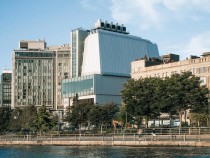
© Karin Jobst?/?©?WMAA
In July 2004 the Italian architect Renzo Piano was commissioned to design the new Whitney Museum of American Art in New York City. The selected site is located in the Meatpacking District at the end of the Highline in Manhattan. The new museum serves as replacement for Marcel Breuer‘s 1966 building in the Upper East Side. With its ample and bright galleries, it offers an impressive panorama of Manhattan and across the Hudson River. Generous exterior stairs lead to an elevated plaza and the glazed entrance area facing Gansevoort Street.
However, the designers couldn‘t foresee the flood disaster that impacted the museum construction site as well as the entire city of New York during the night of October 29th, 2012. Originating in the Caribbean Sea, Hurricane Sandy steered directly towards New York City, accompanied by a huge storm surge. The surge reached a height of 9.65 feet and surpassed the base flood level in the area of the construction site that FEMA (Federal Emergency Management Agency) had determined for a 100 year flood event. The museum had been designed with a waterproof base up to +10 ft. An open and transparent entrance area with a large plaza, the Largo, was situated above it. Yet now the realization was made that this measure offered insufficient flood protection for the museum.
The construction of the new museum had already proceeded so far that a comprehensive redesign was no longer possible. The old base flood levels were obviously no longer sufficient. Neither had new levels yet been determined by FEMA, nor how a related flood protection system should be integrated into the architect‘s design. The aim was to develop a type of flood mitigation that was invisible during everyday operation. WTM Engineers International in collaboration with the Franzius Institut for Hydraulic, Estuarine and Coastal Engineering in Hanover, Germany, received the commission for this task. (Karl Morgen, Friedrich Heiligenstock)
However, the designers couldn‘t foresee the flood disaster that impacted the museum construction site as well as the entire city of New York during the night of October 29th, 2012. Originating in the Caribbean Sea, Hurricane Sandy steered directly towards New York City, accompanied by a huge storm surge. The surge reached a height of 9.65 feet and surpassed the base flood level in the area of the construction site that FEMA (Federal Emergency Management Agency) had determined for a 100 year flood event. The museum had been designed with a waterproof base up to +10 ft. An open and transparent entrance area with a large plaza, the Largo, was situated above it. Yet now the realization was made that this measure offered insufficient flood protection for the museum.
The construction of the new museum had already proceeded so far that a comprehensive redesign was no longer possible. The old base flood levels were obviously no longer sufficient. Neither had new levels yet been determined by FEMA, nor how a related flood protection system should be integrated into the architect‘s design. The aim was to develop a type of flood mitigation that was invisible during everyday operation. WTM Engineers International in collaboration with the Franzius Institut for Hydraulic, Estuarine and Coastal Engineering in Hanover, Germany, received the commission for this task. (Karl Morgen, Friedrich Heiligenstock)










